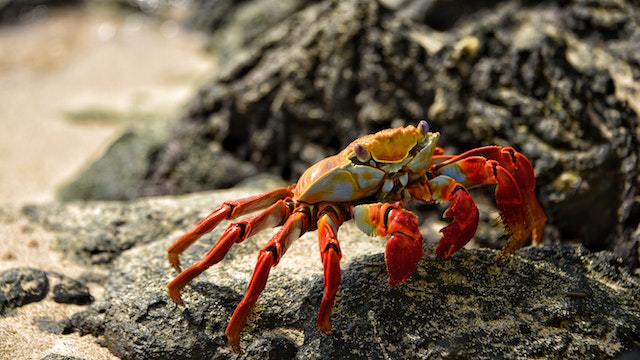
Why do crabs walk sideways? They walk sideways so they don’t trip over their legs. However, some crabs do walk forwards.
There are many different species of crab and they can live in saltwater and in freshwater. The smallest crab is the pea crab, which is only a few millimeters across and is a parasite that lives inside shellfish shells. The largest crab is the Japanese spider crab and they can have a 4 m leg reach with a 40 cm body. Crabs always have a hard exoskeleton and 10 legs. They use eight of their legs to walk on and the front two have the strong claw that they are famous for. Because they have an exoskeleton, they have to molt it every time they grow in size. It differs between species, but they can molt as often as six times a year during their first two years of growth. Some crabs molt as many as twenty times throughout their lives.
The reason crabs walk sideways rather than forwards is because of their knee joints and the location of their legs. We can walk forwards because our legs are directly underneath is and our knee joints are a hinge that allows our lower leg to swing forwards and backwards. Crabs have stiff, jointed legs, that bend outwards. If they try to walk forwards, which they can do, the legs get in the way of each other and they can trip over. They are clumsy and can’t move very quickly forwards. When they move sideways, one set of legs pulls and the opposite set of legs push. The legs don’t get in the way of each other and they can move astonishingly quickly. Ghost crabs are the fastest and they can run at 3.4 m/sec. When crabs really want to move fast, they run on fewer legs, sometimes only on two legs.
Crabs have probably evolved from the same type of crustacean as lobsters, but they have lost their tails. Lobsters have a very large tail relative to their body size, which helps them to swim backwards very quickly when they are being chased by a predator. That is a great advantage in the sea, but a huge disadvantage on the land. The tail means that lobsters can only walk forwards, which means their legs get in the way of each other. Crabs started out like this, but evolution has removed their tail, letting them walk much more quickly and easily.
So, why do crabs have a body that looks like a plate with legs on the edges? Animals that look like crabs have evolved independently at least five times throughout history. This is called convergent evolution and it happens because animals are evolving to leave in similar situations. That must mean the crab shape is good for a reason. So, what is it? The crab shape allows creatures to run fast and it means they don’t have to worry about coordinating their legs. Their wide, flat shape makes it very easy for them to burrow or to squeeze themselves into small spaces. They are able to keep close to the ground, which helps for protection and for finding food. They have a very low center of gravity, which keeps them stable and balanced both in the sea and on the land. Their lack of a tail makes it easier for them to walk and it also removes something that predators could catch onto. So many animals have evolved into a crab shape that there is even a word for it. Carcinization means evolving into a crab shape.
Crabs are able to do all of this without having a brain in the way that we do. The crab has a split nervous system and responsibility for different functions is split between them. Between the crab’s eyes is the dorsal ganglion. This is a group of nerves that process signals from the crab’s eyes. Then the crab has a group of nerves between its legs called the ventral ganglion. This sends nerves to all of the legs to make them move and it processes information from the crab’s other sensory organs. The two collections of nerves are joined together by a circumesophageal ganglion. And this is what I learned today.
Photo by Summer Li: https://www.pexels.com/photo/orange-crab-in-shallow-photo-584501/
Sources
https://www.iflscience.com/why-does-evolution-keep-turning-everything-into-crabs-58459
https://www.reference.com/pets-animals/crabs-brains-8884f4b974c962fb
https://oceanexplorer.noaa.gov/explorations/02alaska/logs/jun27/jun27.html
https://en.wikipedia.org/wiki/Carcinisation
https://en.wikipedia.org/wiki/Crab
https://www.sciencefocus.com/nature/why-do-crabs-walk-sideways/
https://www.discoverwildlife.com/animal-facts/marine-animals/why-do-crabs-walk-sideways/
https://www.tampabay.com/archive/1994/12/20/why-do-crabs-walk-sideways/
https://www.popularmechanics.com/science/animals/a42235392/crab-evolution-carcinization-explained/
